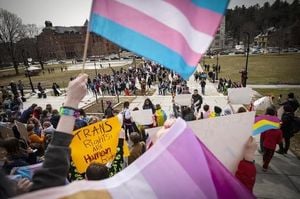President Donald Trump took a decisive step on Thursday, July 24, 2025, by signing an executive order aimed at reshaping the nation’s approach to homelessness. The order, titled "Ending Crime and Disorder on America’s Streets," directs cities and states to intensify efforts to remove homeless individuals from public spaces, emphasizing treatment and institutionalization over housing-first strategies that have dominated recent years.
The executive action tasks Attorney General Pam Bondi with reversing federal and state judicial precedents and ending consent decrees that have limited local governments’ ability to relocate homeless people from streets and encampments into treatment centers. It also redirects federal funding to ensure that those affected are transferred to rehabilitation, substance abuse programs, and other facilities, although the exact amount of money allocated remains unclear.
Bondi has been instructed to collaborate with the secretaries of Health and Human Services, Housing and Urban Development, and Transportation to prioritize federal grants for states and cities that enforce prohibitions on open illicit drug use, urban camping, loitering, squatting, and that track the location of sex offenders. White House press secretary Karoline Leavitt emphasized the administration’s goals, stating, "By removing vagrant criminals from our streets and redirecting resources toward substance abuse programs, the Trump administration will ensure that Americans feel safe in their own communities and that individuals suffering from addiction or mental health struggles are able to get the help they need." She added this was part of fulfilling Trump’s commitment to "Make America Safe Again and end homelessness across America."
California, with the highest homeless population in the nation, stands at the center of this policy shift. A 2025 U.S. Senate Housing Committee report found that just over 187,000 people were homeless in California, a 3% increase from the previous year, accounting for 28% of the nation’s homeless population despite the state comprising just 11.7% of the U.S. population. Alarmingly, 66% of these individuals were unsheltered, the highest rate nationwide.
Governor Gavin Newsom has been proactive in addressing homelessness, allocating $1 billion in grants in 2023 and pushing cities to outlaw homeless encampments. In early 2025, Newsom released a "model ordinance" encouraging cities to ban camping, stating, "There’s nothing compassionate about letting people die on the streets." However, Newsom’s office criticized Trump’s executive order, calling it based on "harmful stereotypes and ineffective policy," though they acknowledged that Trump’s imitation was "the highest form of flattery."
This executive order builds on a June 2024 Supreme Court decision that upheld the right of cities to arrest and fine homeless individuals for sleeping in public spaces. The 6-3 ruling overturned a lower court’s decision that such enforcement constituted cruel and unusual punishment when shelters were unavailable. The case originated in Grants Pass, Oregon, where homeless residents face fines starting at $250 and possible jail time for repeat offenses. Since then, over 100 cities and two dozen states have enacted similar laws.
Trump’s order also shifts the federal government’s approach from housing-first policies, which prioritize permanent housing as the initial step out of homelessness, to a model that emphasizes treating substance abuse and mental health issues, often through civil commitment. The order states, "Shifting homeless individuals into long-term institutional settings for humane treatment through the appropriate use of civil commitment will restore public order." This marks a significant departure from previous strategies, with housing becoming a lesser priority.
In a statement on the White House lawn on July 25, 2025, Trump said, "We can’t have it — when leaders come to see me to make a trade deal for billions and billions and even trillions of dollars, and they come in and there’s tents outside of the White House, we can’t have that. It doesn’t sound nice." He reiterated his commitment from a 2023 campaign video: "We will use every tool, lever, and authority to get the homeless off our streets. We want to take care of them, but they have to be off our streets." The order also prohibits convicted sex offenders receiving homelessness assistance from being housed with children and supports programs exclusively housing women and children. Additionally, it seeks to defund "harm reduction" addiction programs, such as supervised drug injection sites and needle exchanges, claiming these encourage illicit drug use.
However, the order has faced significant backlash from homelessness advocates and legal experts. Jesse Rabinowitz, communications director for the National Homelessness Law Center, condemned the approach, stating, "The safest communities are those with the most housing and resources, not those that make it a crime to be poor or sick." He further criticized forced treatment as "unethical, ineffective, and illegal," emphasizing that "people need stable housing and access to healthcare." Rabinowitz warned that the executive order would likely increase homelessness by diverting taxpayer money away from people in need and making solutions harder to implement.
Donald Whitehead, Jr., executive director of the National Coalition for the Homeless, called the order "a punitive approach that has consistently failed to resolve homelessness and instead exacerbates the challenges faced by vulnerable individuals." Legal experts also caution that the civil commitment provisions could violate due process rights under the 14th Amendment, which requires "clear and convincing" evidence of serious mental illness and an immediate threat to health or safety before involuntary institutionalization.
The broader context highlights a growing homelessness crisis in the United States. According to a 2024 HUD count, more than 771,800 people experienced homelessness on a single night, an 18.1% increase from 2023’s count of approximately 650,000. Over one-third of those individuals were unsheltered, living in encampments, vehicles, or on the streets. The National Low Income Housing Coalition reports a nationwide shortage of 7.1 million affordable rental homes for extremely low-income renters, underscoring the structural housing crisis fueling homelessness.
Trump’s executive order thus represents a stark shift toward a law-and-order approach to homelessness, emphasizing removal, treatment, and enforcement over housing expansion and supportive services. While some cities like Los Angeles, Seattle, and Fort Lauderdale have already taken steps to restrict homelessness, this federal push aims to strengthen and expand such efforts nationwide.
As the nation grapples with this complex issue, the debate continues over the most humane and effective strategies. Will criminalizing homelessness and prioritizing institutional treatment restore public order, or will it deepen the crisis by ignoring the root causes such as housing affordability and economic inequality? For now, the order sets a new tone in federal policy, one that promises to reshape how America confronts homelessness in the years ahead.





